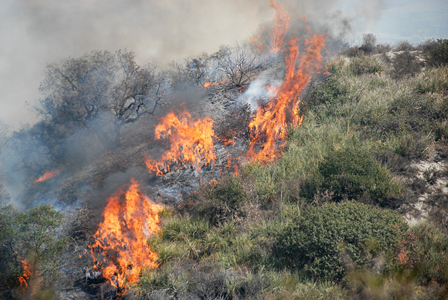Wildfires, urbanization, and land-clearing for agriculture can be considered among the most important environmental disturbances in Mediterranean regions. Interspecific hybridization has been suggested to be linked to different sources of anthropogenic disturbance, but empirical support to this hypothesis is sparse. This study analyses the impacts of different sources of environmental disturbance on hybridization rates between two Californian oaks, the serpentine-soil specialist leather oak (Quercus durata) and the widespread Californian scrub oak (Quercus berberidifolia). Extensive genotypic obtained data across the distribution ranges of the two species revealed considerable rates of hybridization (> 25%), asymmetric gene flow from Q. durata into Q. berberidifolia, and a higher occurrence of hybrids in areas where both species live in geographical proximity. The analyses also showed that genetic admixture increased with wildfire frequency, but other sources of human-induced habitat alteration (urbanization, land clearing for agriculture) or a suite of ecological factors (climate, elevation, soil type) had no significant effects on hybridization rates. Overall, these findings reveal for the first time that wildfires constitute an important source of environmental disturbance that promotes hybridization between two ecologically well-differentiated native species. informacion[at]ebd.csic.es: Ortego et al (2016) Impacts of human-induced environmental disturbances on hybridization between two ecologically differentiated Californian oak species. New Phytol doi: 10.1111/nph.14182
http://onlinelibrary.wiley.com/doi/10.1111/nph.14182/full

 Las altas temperaturas están provocando que las lagunas y las marismas de Doñana pierdan agua rápidamente
Las altas temperaturas están provocando que las lagunas y las marismas de Doñana pierdan agua rápidamente




